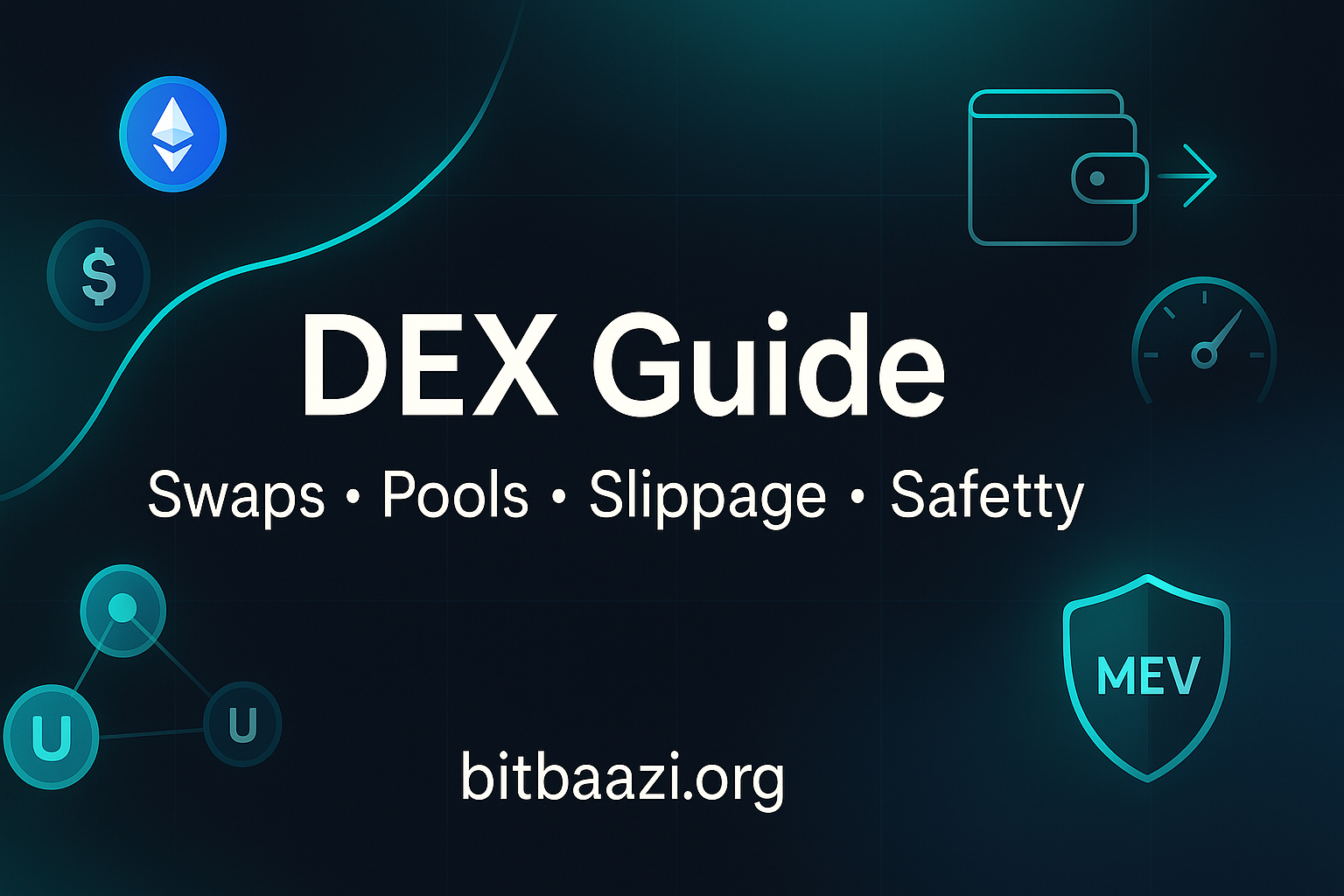Summary
- Trade from your wallet via audited smart contracts.
- Understand price impact vs. slippage before swapping.
- Cut MEV risk with private transactions and smart routing.
- Approve tokens safely and review allowances regularly.
Intro. A decentralized exchange lets you swap directly from self-custody, and this guide explains how a DEX works, what shapes execution, and how to trade safely.
What a decentralized exchange does
Swaps execute against permissionless liquidity pools.
In pool-based markets, users deposit token pairs into smart contracts and earn fees as traders swap against that liquidity. Orders settle on-chain from your wallet; there is no central order book or custody. Pricing emerges algorithmically and updates as trades move the pool’s balance. Protocols like Uniswap add safety checks around slippage and deadlines so pending transactions do not clear far from the quoted rate.
Pricing: price impact, slippage, and gas
Three forces determine what you actually receive.
Price impact is the change your own trade causes in the pool price; slippage is the gap between the expected quote and the final execution, which can shift while your transaction is pending. You control slippage tolerance, but thin liquidity, volatile markets, or reordering by block builders can widen outcomes. Understanding the difference helps you set realistic limits and avoid failed swaps.
Steps to trade safely
Prepare, simulate, and protect the transaction path.
Start by verifying the token contract address and chain, then approve only the minimum allowance needed for the swap and review allowances periodically. Aggregators (e.g., 0x) route across venues and can add slippage-aware algorithms and fallback orders to improve reliability. Setting conservative deadlines and slippage tolerance reduces surprises. To lower sandwich/front-run risk, send private transactions via tools like Flashbots Protect or wallets that offer MEV-aware submission.
FAQ
What’s “price impact” vs. “slippage” in Uniswap (2025)?
Impact is your trade moving the pool; slippage is quote vs. final price.
How can I cut MEV risk in 2025 on Ethereum?
Use private submission (e.g., Flashbots) or wallet “Smart Transactions.”
Do I need token approvals before a first swap?
Yes; approve minimal spend and later reduce or revoke if not needed.
Are aggregators safer for price in volatile periods?
They can route across pools and add slippage protection/fallbacks.
Takeaways
- Trade from self-custody; confirm token address and network each time.
- Distinguish price impact from slippage and set tolerance deliberately.
- Prefer routes with slippage/MEV protection; set deadlines.
- Approve the minimum; audit allowances and revoke excess.
- This article is educational and not investment advice.
作用与流程
交易在你的钱包与智能合约之间直接完成。
在资金池模型中,用户将两种代币存入合约形成流动性,交易者与该池进行换币,流动性提供者赚取手续费。订单在链上从你的钱包结算,没有中心化托管或撮合;价格由算法随交易动态更新。主流协议会提供滑点和截止时间等安全检查,帮助减少挂单期间的执行偏差(如 Uniswap 的做法)。
定价:价格影响、滑点与Gas
三者共同决定你最终拿到的数量。
价格影响指的是你的订单推动池子价格的变化;滑点是期望报价与最终成交之间的差值,可能在交易等待打包时扩大。你可以设置滑点容忍度,但流动性稀薄、波动剧烈或打包排序引发的重排都可能放大结果。理解两者差异有助于合理设定参数并避免失败。
安全步骤
先核验,再授权,后路由,必要时走私有通道。
先确认代币合约地址与链,再只授权本次所需的最小额度,并定期检查与回收多余授权。聚合器(如 0x)会在多交易所间路由,并引入防滑点与回退订单机制,提升成交可靠性。设置保守的截止时间与滑点容忍度能降低意外。为降低三明治/抢跑,可使用私有交易通道(如 Flashbots Protect)或带相关功能的钱包。本文仅介绍操作常识;如需术语统一,文中只在此处出现一次“DEX”。
分散型取引所の働き
スワップは自分のウォレットからスマコンに直結する。
プール型市場では、ユーザーが2種トークンを預けて流動性を作り、トレーダーがそのプールと交換し、提供者は手数料を得ます。注文はオンチェーンで決済され、中央管理や板は不要です。価格はアルゴリズムで変動し、Uniswap などはスリッページや期限のチェックで約定の乖離を抑えます。
価格形成:価格影響・スリッページ・ガス
最終受取量はこの三要素で決まる。
価格影響は自分の取引がプール価格を動かす度合い、スリッページは見積りと実約定の差です。待機中の相場変化やブロック内の並べ替えで差は拡大し得ます。許容度と期限を適切に設定し、薄い板では注意しましょう。
安全に取引する手順
確認・最小承認・良質ルート・必要なら私設メンプール。
まずトークンアドレスとチェーンを確認し、承認(Allowance)は必要最小に限定、定期的に見直します。アグリゲーター(例:0x)は複数プールを横断し、スリッページ保護やフォールバック注文で約定を安定させます。フロントラン対策には Flashbots Protect などのプライベート送信や、対応するウォレット機能が有効です。用語統一のため、本稿で “DEX” の記載はここで一度だけにとどめます。
